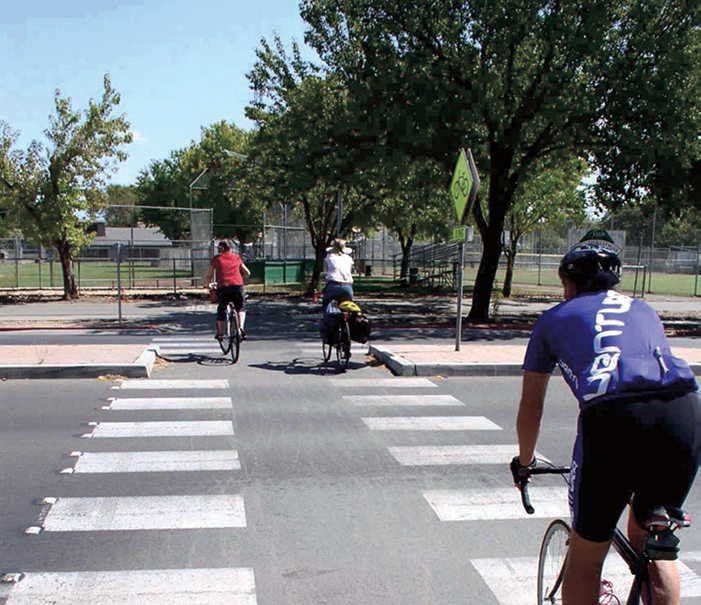
Major Street Crossings

DAVIS, CA
At locations where a bicycle boulevard crosses a major street with right-of-way priority, a variety of measures may improve visibility and reduce delay for bicyclists.
Treatments can be categorized into the following groups:
1. Supplemental signs and markings that enhance crosswalks, including advance stop bars and advance signing.
2. Geometric elements, including median refuge islands and curb extensions.
3. Crossing devices, including crosswalks, warning signs/markings/beacons, actuated warning beacons, and signals.
Major street crossings may pose a significant barrier the effectiveness and quality of a bicycle boulevard. Treatments of high quality should be selected to mitigate these barriers. Otherwise, it is recommended that another route or crossing that permits a higher level treatment should be selected. Selection of a given treatment depends upon several factors, including roadway width, speed, visibility, and the number and regularity of gaps.159
Unsignalized Intersections
At unsignalized crossings of major streets, treatments should aim to decrease crossing distance, increase the number of available crossing gaps, improve visibility for bicyclists and people using the cross street, and/or enhance the general awareness of the crossing.
Treatments appropriate for streets with three or fewer travel lanes and posted speeds below 35 mph vary with conditions and operational characteristics of the cross street. Treatments may include the following elements:
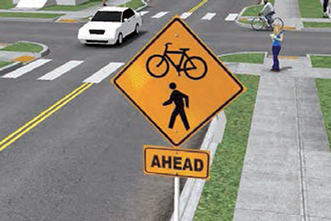
Advance warning signs notify motorists that they are about to cross a bicycle boulevard and remind them to watch for people walking and bicycling.160
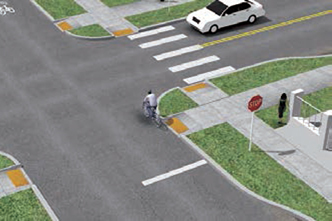
Curb extensions shorten crossing distances and allow crossing bicyclists and pedestrians to make use of shorter gaps. They may be used in conjunction with a variety of other intersection treatments, and should only be used as a stand-alone crossing device where they will provide additional crossing gaps in a location with insufficient existing crossing opportunities.
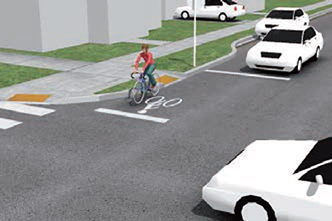
A bicycle forward stop bar—used in conjunction with a curb extension—is placed closer to the intersection than the motor vehicle stop bar in a location that does not block the crosswalk. Encouraging bicyclists to stop at the nose of the curb extension helps bicyclists take full advantage of the design by decreasing the crossing distance. It also improves bicyclists’ view of cross traffic and provides better visibility of bicyclists waiting for a crossing opportunity. Colored paint may be used to bring further attention to this space.161
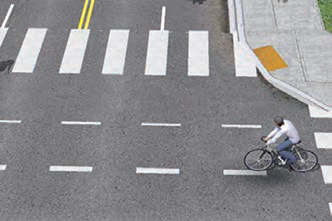
Intersection crossing markings or standard crosswalks can be used to highlight to cross traffic that bicyclists are crossing the roadway in that location. They may be used with crossing warning signs for bicycles or bicycles and pedestrians (MUTCD sign W11-1 or W11-15).
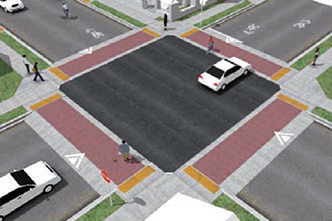
A raised intersection is a speed management device that increases motorist awareness of the crossing while reducing motor vehicle speeds on the cross street. This treatment is also a Speed Management tool; see Route Planning for a discussion of bicycle boulevards and emergency vehicle routes.
Crossings of higher order streets with three or more travel lanes and posted speeds over 35 mph should improve safety and comfort for bicyclists. Treatments include the following elements:
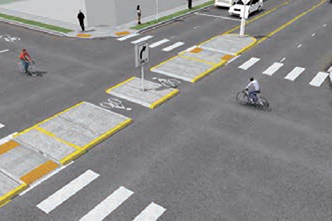
A median refuge island allows bicyclists to cross one direction of traffic at a time when gaps in traffic allow. Islands placed in the middle of the intersection narrow the cross street, providing some speed management benefit. They can also be used to prohibit left turns by motor vehicles on the cross street and through movements on the bicycle boulevard, thus also acting as a volume management treatment. Median refuge islands should be wide enough along bicycle boulevards to accommodate more than one bicyclist or longer bicycles such as cargo bikes and trail-a-bikes.
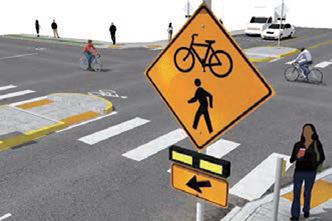
Active warning beacons can be placed across a bicycle boulevard crossing of a major street. Rectangular Rapid Flash Beacons (RRFBs) are commonly used to alert drivers to crossing bicyclists and increase yielding behavior.”

Hybrid beacons can facilitate bicycle crossing of a busy street where cross traffic does not stop but side street volumes do not warrant installation of a conventional traffic signal, or where a full traffic signal installation is not desired.
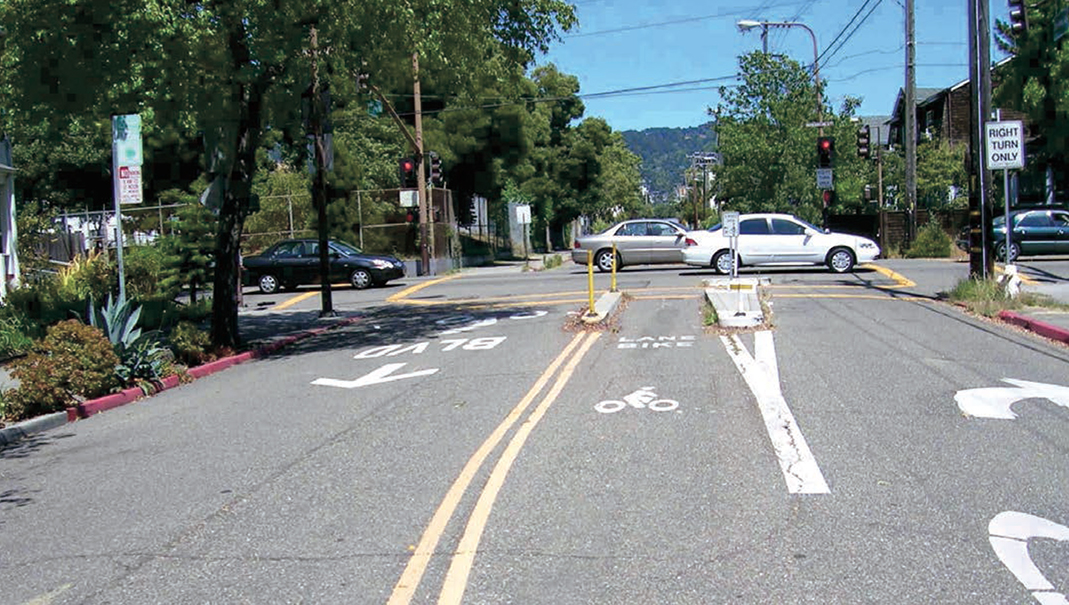
BERKELEY, CA
Signalized Intersections
Full traffic signals may be added to create gaps, overcome visibility issues, or force motorists to stop if needed (see signals). Signal installation can also alleviate a congestion problem on the main road caused by a high volume bicycle/pedestrian crossing by limiting when bicyclists or pedestrians can cross.
On streets with few crossing gaps and high motor vehicle speeds and volumes, a bicycle/pedestrian-actuated hybrid beacon should be considered. This will reduce delay at non-peak times when bicyclists do not otherwise need to wait for a gap in traffic on the cross street as well as for users on the cross street, who are not delayed with a full signal. It also reduces the likelihood of generating cut-through traffic on the bicycle boulevard route.162
If the intersection is fully signalized, it shall provide bicycle signal detection and actuation. Volume management may be required so that the signal does not attract unwanted vehicular cut-through traffic. However, forced turns may increase the frequency of right-turn conflicts between bicyclists and motorists. Enhancements to signals on bicycle boulevards to address these issues include the following treatments:
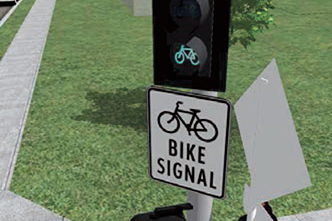
Bicycle signal heads can be added to a hybrid beacon to improve function and safety for bicyclists. See Bicycle Signal Heads for additional guidance.
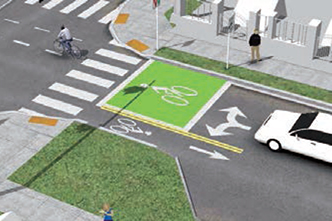
Signs that prohibit through movements, right-in/right-out splitter islands, and partial closures are volume management strategies to reduce cut-through motor vehicle traffic. Signs are typically less effective than physical diversion.
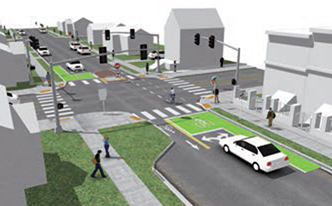
Bike boxes allow bicyclists to get to the head of the queue at signalized intersections. This allows them to take advantage of the typically short green time provided to the minor roadway at an intersection with a major roadway. Such boxes also increase bicyclist visibility to drivers. Parking removal should be considered where a bicycle boulevard has insufficient space to provide the ingress lane to a bike box.

TUCSON, AZ
Benefits
Provides bicycle access across streets that can be major barriers along the bicycle boulevard and that compromise bicyclist safety. Because bicycle boulevard retrofits to local streets are typically along facilities without existing signalized accommodation at crossings of collector and arterial roadways, these treatments significantly improve connectivity and access.
Reduces the crossing distance and improves visibility of bicyclists, encouraging drivers to allow other users to cross safely.
Aids pedestrian crossing and improves pedestrian connectivity.
Raises awareness for both bicyclists and drivers of potential conflict areas.
Encourages or requires driver yielding behavior, allowing bicyclists to cross.
Minimizes delay for bicyclists on the bicycle boulevard.
Promotes the multi-modal nature of the corridor.
Signals separate bicycle movements from conflicting motor vehicle, streetcar, light rail, or pedestrian movements.
Provides priority to bicycle movements at an intersection (e.g., with a leading bicycle interval or bike box).
Protects bicyclists in the intersection, which may improve real and perceived safety and comfort.
Typical Applications
Anywhere bicycle boulevards intersect streets that are not stop controlled (generally higher-order streets).
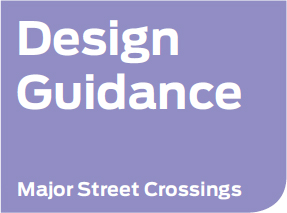

Required Features
 Crossing devices shall be considered at any bicycle boulevard crossing of a roadway that is not stop controlled. Treatments should be selected based on the number of existing gaps and the desired gap profile.163
Crossing devices shall be considered at any bicycle boulevard crossing of a roadway that is not stop controlled. Treatments should be selected based on the number of existing gaps and the desired gap profile.163
 All beacons and signals shall be installed with appropriate detection and actuation, unless the bicycle boulevard crossing phase is set to recall each cycle.
All beacons and signals shall be installed with appropriate detection and actuation, unless the bicycle boulevard crossing phase is set to recall each cycle.
Recommended Features
 Supplemental signs and markings such as warning signs and crosswalk markings should be provided at bicycle boulevard crossings of major roads to improve crossing visibility.
Supplemental signs and markings such as warning signs and crosswalk markings should be provided at bicycle boulevard crossings of major roads to improve crossing visibility.
 At signalized intersections, longer minimum green times should be provided for bicyclists due to slower acceleration speeds. See detection and actuation for more information.
At signalized intersections, longer minimum green times should be provided for bicyclists due to slower acceleration speeds. See detection and actuation for more information.
 Volume management should be considered at signalized intersections along the bicycle boulevard to discourage motorists from using the route.
Volume management should be considered at signalized intersections along the bicycle boulevard to discourage motorists from using the route.
Optional Features
 Geometric elements such as median refuge islands, curb extensions, neckdowns, and raised crosswalks may be provided to improve sight distance for bicyclists on the bicycle boulevard as well as for drivers on the cross street.
Geometric elements such as median refuge islands, curb extensions, neckdowns, and raised crosswalks may be provided to improve sight distance for bicyclists on the bicycle boulevard as well as for drivers on the cross street.
 At stop-controlled unsignalized crossings with curb extensions, forward stop bars for bicyclists may be provided.
At stop-controlled unsignalized crossings with curb extensions, forward stop bars for bicyclists may be provided.

TUCSON, A Z (CREDIT: CITY OF TUCSON)
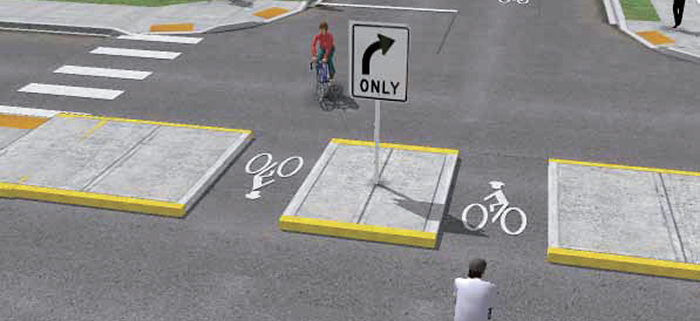
PORTLAND, OR
Crossing major streets without signalization requires an adequate number of acceptable gaps. Treatments that reduce the duration of the minimum acceptable gap can improve the number of crossing opportunities for bicyclists.
To calculate the minimum acceptable gap for a bicyclist to cross a major roadway the following equation is adapted from the ITE Manual of Traffic Engineering Studies (describing minimum acceptable gaps for pedestrians):
G = ( W / S ) + R
G = minimum acceptable gap, sec
W = crossing distance or width of roadway, ft
S = bicycling speed, ft/s
(assumed to be 10 ft/sec for a bicyclist)
R = start-up time, s
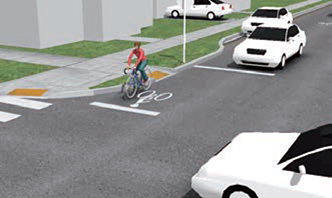
A bicycle forward stop bar can reduce the minimum acceptable gap by one second per side of the street.
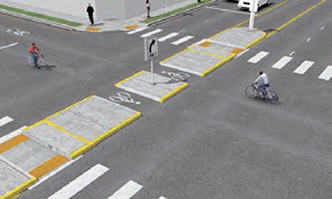
A median refuge area can cut the acceptable gap needed to cross a major street by 50 percent.
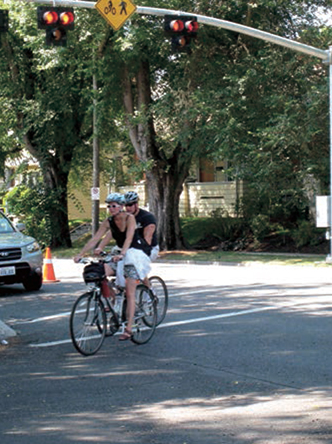
PORTLAND, OR
Maintenance
Maintain signs, markings, and other treatments, and replace as needed. Monitor intersections for bicyclist delay to determine if additional treatments are warranted.
Bicycle signal heads require the same maintenance as standard traffic signal heads, such as replacing bulbs and responding to power outages.
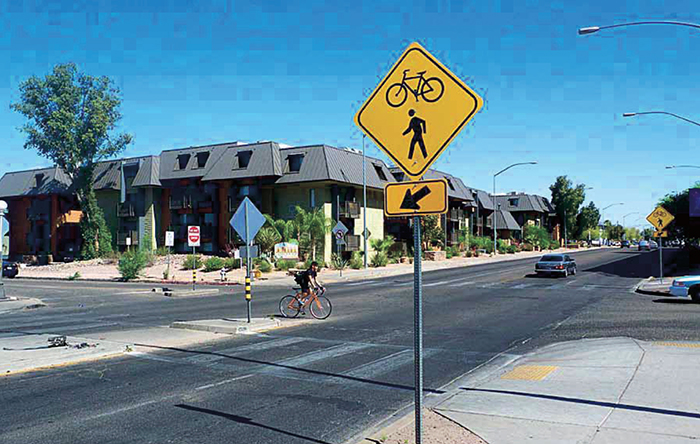
TUCSON, A Z (PHOTO: MICHAEL MCKISSON, TUCSONVELO.COM)
Treatment Adoption and Professional Consensus
See adoption and consensus information for specific treatment types under the relevant treatment pages.